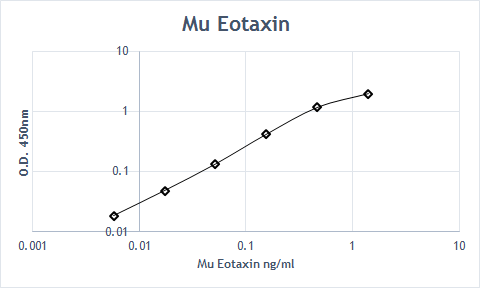Mouse CCL11/Eotaxin Biotinylated Antibody Summary
Applications
Mouse CCL11/Eotaxin Sandwich Immunoassay
Please Note: Optimal dilutions should be determined by each laboratory for each application. General Protocols are available in the Technical Information section on our website.
Scientific Data
 View Larger
View Larger
CCL11/Eotaxin in Mouse Colon. CCL11/Eotaxin was detected in perfusion fixed frozen sections of mouse colon using Goat Anti-Mouse CCL11/Eotaxin Biotinylated Antigen Affinity-purified Polyclonal Antibody (Catalog # BAF420) at 15 µg/mL overnight at 4 °C. Tissue was stained using the Anti-Goat HRP-DAB Cell & Tissue Staining Kit (brown; Catalog # CTS008) and counterstained with hematoxylin (blue). Specific staining was localized to cytoplasm. View our protocol for Chromogenic IHC Staining of Frozen Tissue Sections.
Reconstitution Calculator
Preparation and Storage
Background: CCL11/Eotaxin
CCL11 is a potent eosinophil chemoattractant that was originally purified from bronchoalveolar lavage fluid of guinea pigs sensitized by aerosol challenge with ovalbumin. Microsequencing of the purified protein revealed the guinea pig CCL11 to be a member of the beta (CC) chemokine family of inflammatory and immunoregulatory cytokines. cDNA clones for guinea pig, mouse and human CCL11 have been isolated. Mouse CCL11 cDNA encodes a 97 amino acid residue precursor protein from which the amino-terminal 23 amino acid residues are cleaved to generate the 74 amino acid residue mature mouse CCL11. At the protein sequence level, mature mouse CCL11 is approximately 60% identical to mature human and guinea pig CCL11. In addition, mouse CCL11 also shows high amino acid sequence identity to members of the MCP family. Mouse CCL11 is chemotactic for eosinophils, but not mononuclear cells or neutrophils. CCL11 mRNA is expressed in a variety of tissues. The expression of CCL11 mRNA is induced in cultured endothelial cells in response to IFN-gamma. In addition, CCL11 mRNA is also induced in response to the transplantation of IL-4-secreting tumor cells. The CC chemokine receptor 3 (CCR3) has now been identified to be a specific human CCL11 receptor.
- Rothenberg, M.E. et al. (1995) Proc. Natl. Acad. Sci. USA 92:8960.
- Kitaura, M. et al. (1996) J. Biol. Chem 271:7725.
- Garcia-Zepeda, E.A. et al. (1996) Nature Medicine 2:449.
- Ponath, P.D. et al. (1996) J. Clin. Invest. 97:604.
Product Datasheets
Citations for Mouse CCL11/Eotaxin Biotinylated Antibody
R&D Systems personnel manually curate a database that contains references using R&D Systems products. The data collected includes not only links to publications in PubMed, but also provides information about sample types, species, and experimental conditions.
11
Citations: Showing 1 - 10
Filter your results:
Filter by:
-
Helminth-induced CD19+CD23hi B cells modulate experimental allergic and autoimmune inflammation
Authors: Mark S. Wilson, Matthew D. Taylor, Mary T. O'Gorman, Adam Balic, Tom A. Barr, Kara Filbey et al.
European Journal of Immunology
-
Response patterns of cytokines/chemokines in two murine strains after irradiation.
Authors: Zhang M, Yin L, Zhang K, Sun W, Yang S, Zhang B, Salzman P, Wang W, Liu C, Vidyasagar S, Zhang L, Ju S, Okunieff P, Zhang L
Cytokine, 2012-01-25;58(2):169-77.
Species: Mouse
Sample Types: Plasma
Applications: Luminex Development -
Resolution of allergic inflammation and airway hyperreactivity is dependent upon disruption of the T1/ST2-IL-33 pathway.
Authors: Kearley J, Buckland KF, Mathie SA, Lloyd CM
Am. J. Respir. Crit. Care Med., 2009-01-29;179(9):772-81.
Species: Mouse
Sample Types: Cell Culture Supernates
Applications: ELISA Development -
IL-13Ralpha2 and IL-10 coordinately suppress airway inflammation, airway-hyperreactivity, and fibrosis in mice.
Authors: Wilson MS, Elnekave E, Mentink-Kane MM, Hodges MG, Pesce JT, Ramalingam TR, Thompson RW, Kamanaka M, Flavell RA, Keane-Myers A, Cheever AW, Wynn TA
J. Clin. Invest., 2007-10-01;117(10):2941-51.
Species: Mouse
Sample Types: Serum
Applications: ELISA Development -
Circulating cytokine/inhibitor profiles reshape the understanding of the SIRS/CARS continuum in sepsis and predict mortality.
Authors: Osuchowski MF, Welch K, Siddiqui J, Remick DG
J. Immunol., 2006-08-01;177(3):1967-74.
Species: Mouse
Sample Types: Plasma
Applications: ELISA Development -
Sequential ELISA to profile multiple cytokines from small volumes.
Authors: Osuchowski MF, Siddiqui J, Copeland S, Remick DG
J. Immunol. Methods, 2005-07-01;302(1):172-81.
Species: Mouse
Sample Types: Plasma
Applications: ELISA Development -
A soluble chemokine-binding protein from vaccinia virus reduces virus virulence and the inflammatory response to infection.
Authors: Reading PC, Symons JA, Smith GL
J. Immunol., 2003-02-01;170(3):1435-42.
Species: Mouse
Sample Types: BALF
Applications: ELISA Development -
P-selectin mediates IL-13-induced eosinophil transmigration but not eotaxin generation in vivo: a comparative study with IL-4-elicited responses.
Authors: Larbi KY, Dangerfield JP, Culley FJ, Marshall D, Haskard DO, Jose PJ, Williams TJ, Nourshargh S
J. Leukoc. Biol., 2003-01-01;73(1):65-73.
Species: Mouse
Sample Types: Peritoneal Fluid
Applications: ELISA Development -
AMD3100, a CxCR4 antagonist, attenuates allergic lung inflammation and airway hyperreactivity.
Authors: Lukacs NW, Berlin A, Schols D, Skerlj RT, Bridger GJ
Am. J. Pathol., 2002-04-01;160(4):1353-60.
Species: Mouse
Sample Types: Tissue Homogenates
Applications: ELISA Development -
Longitudinal Multiplexed Measurement of Quantitative Proteomic Signatures in Mouse Lymphoma Models Using Magneto-Nanosensors
Authors: JR Lee, I Appelmann, C Miething, TO Shultz, D Ruderman, D Kim, P Mallick, SW Lowe, SX Wang
Theranostics, 2018-02-03;8(5):1389-1398.
-
Ablation of Tumor Progression Locus 2 Promotes a Type 2 Th Cell Response in Ovalbumin-Immunized Mice
Authors: Wendy T. Watford, Chun-Chi Wang, Christos Tsatsanis, Lisa A. Mielke, Aristides G. Eliopoulos, Constantine Daskalakis et al.
The Journal of Immunology
FAQs
No product specific FAQs exist for this product, however you may
View all Antibody FAQsReviews for Mouse CCL11/Eotaxin Biotinylated Antibody
Average Rating: 5 (Based on 2 Reviews)
Have you used Mouse CCL11/Eotaxin Biotinylated Antibody?
Submit a review and receive an Amazon gift card.
$25/€18/£15/$25CAN/¥75 Yuan/¥1250 Yen for a review with an image
$10/€7/£6/$10 CAD/¥70 Yuan/¥1110 Yen for a review without an image
Filter by:
Used as detection in ELISA




